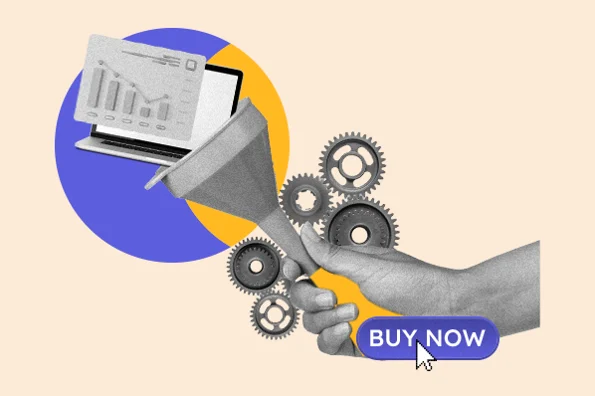Table of Contents
Sales Process Cheat Sheet
In this sales process cheat sheet, I outline the major steps of the buying journey and share tips to help you bring in prospects, identify high-quality leads, and convert them into customers.
Prospecting
Prospecting is the first stage of the sales process, where I look for potential customers to contact. At this point, I’m dealing with the largest number of possible leads, so I use the following tips to streamline the work and narrow down my pool to the best opportunities.
Use a prospecting framework.
A prospecting framework like BANT or GPCTBA keeps me focused on the factors that will help me identify the best leads. These include budget, goals, timeline, and challenges. Choosing a framework also ensures I apply the same criteria to each potential lead, enabling my sales team to achieve consistent results.
Follow prospect blogs and social networks.
Research is key during prospecting, so I always follow company blogs and key decision-makers on social media to gather information for my frameworks. This is also an excellent way to find topics for cold outreaches and follow-ups.
Leverage sales prospecting tools.
In our survey of sales professionals, 26% say that prospecting platforms are the most effective tools for winning deals, making them the second most important tool after customer relationship management (CRM) platforms.
I use a sales prospecting software – specifically HubSpot’s Lead Management & Prospecting Software — to organize each prospect’s contact information and insights from my research along with reminders to follow up with each opportunity.

Preparation and Research Tips
Once I’ve narrowed down my prospects list to the high-priority opportunities that look like the best fit for my offering, it’s time to prepare for outreach.
Here are the steps I follow to increase prospect engagement.
Research before every call.
In my experience, doing your research demonstrates your commitment and makes it easier for prospects to trust you.
Emily Hartzell, VP and senior director at LeadG2, puts it best by saying: “Before reaching out, spend time researching your prospects. Understand their business, industry, and challenges. This knowledge will help you craft a compelling value proposition and build credibility.”
Prepare relevant materials.
Once I’m familiar with a prospect’s business, I like to gather relevant content to use in calls and emails. Examples include case studies that address their specific pain points, testimonials from similar brands, and research or white papers that apply to their industry.
Set a goal for the outreach.
I like to set clear goals for each cold outreach to ensure I’m not wasting anyone’s time. According to the sales professionals we surveyed, the most effective channels for selling are in-person meetings (selected by 51%) and phone calls (selected by 46%). So, I like to set one of those as my goal. In the call or demo, I can gather more information to further qualify potential clients and lay the groundwork for new business.
Call Openers
Cold calling is often a necessary but daunting task. Here are the top tips I follow to make cold calls less intimidating and more successful.
Use a call script.
In our survey, we found that 20% of salespeople who use enablement materials leverage scripts, and 19% use pre-call templates. Personally, I’m a fan of using cold call scripts because they provide a much-appreciated confidence boost and help me stay consistent. That said, I also like to tell reps they can be flexible and adapt the script based on the responses they get from each prospect.
I also like to use templates for cold emails if I can’t reach a prospect on the phone. This email from HubSpot’s free Sales Plan Template starts with a conversational greeting and personalization to help build rapport.

Keep your greeting warm.
In my experience, starting a sales call with a warm and friendly greeting sets the best foundation for relationship-building. Ultimately, I want the person on the other end of the line to know that I care about them and their business, not feel as if I’m only after a sale. Using the first minute or so to establish this base takes pressure off both parties.
Look for an early “yes.”
Sales wins don’t just happen at the last stage when it’s time to close the deal. They’re often the result of many “yesses” that build momentum along the way. That’s why I like to find early points of agreement right at the start by asking questions that I’m confident they’ll answer with a “yes.”
For instance, I could ask: “Would you agree that your team would benefit from having more time to interact with customers?”
Qualifying Leads
Once a prospect has turned into a lead, I use my early interactions to qualify each opportunity so I can see who’s most likely to become a customer. At this stage, I like to use tools that help me gather the most relevant information and evaluate leads using consistent criteria.
HubSpot’s free email tracker is one of my favorites. It helps me see how my leads engage with my emails. I can also see their entire history at a glance.
Create an ideal customer profile (ICP).
Before I start the qualifying process, I like to have an ideal customer profile (ICP), which is a description of the perfect customer for my product. Specifically, I look at what makes someone a good match for my product, considering both their willingness to buy and their financial ability to do so.
Leverage qualification frameworks.
When qualifying sales leads, I always rely on frameworks to help me identify the most relevant leads and use objective information for optimal time management. If you used a framework during prospecting, you can rely on it during qualification as well. At this stage, you’ll be able to fill it out in more detail because you’ve opened a dialogue with the lead, and you can ask questions.
Ask targeted qualifying questions.
According to our survey, the top reasons for leads to back out of the sales process are:
- They aren’t ready to make a purchase (reported by 34%).
- The lead isn’t convinced the product or service is right for them (reported by 28%).
- Your product or service doesn’t solve the right problem (reported by 26%).
So, I like to ask questions that help me figure out if a lead is in one of these categories. Specifically, I want to understand their buying timeline, what they look for in a provider, and which pain points they want to solve. It’s also helpful to confirm which team members are involved in the buying process and who’s the ultimate decision maker.
Crafting the Perfect Pitch/Demo
After I’ve qualified my leads, it’s time to move on to a product demo or sales pitch. 30% of sales professionals who use sales enablement say that product demos resonate the most with prospects, making it the most effective tool after testimonials.
Here are the steps I take to get the most out of demos.
Personalize demos.
By the time I reach the demo stage, I’ve done my research and qualified the lead. So, I use all of that information to tailor each presentation to the buyer. If I’ve learned that their team is less tech-savvy than others, I make sure to highlight our platform’s ease of use and helpful support so they can feel confident that they’ll get the most out of their purchase.
Lean into storytelling.
In my experience, nothing sells like a good story. Yes, you need to have a solid product that suits your customer’s needs, but tying this together in a narrative makes your presentation more impactful and memorable.
Use demos as an opportunity to paint your lead as the hero while positioning your product as the tool that helps them achieve their goals.
Encourage interaction.
One thing I always stress to sales reps is that demos are not one-way conversations. You still want to learn as much as you can during these calls so you can effectively handle objections and close the deal.
If the lead isn’t speaking much, I like to pause and ask if they have any questions or if they agree with what I’ve said so far.
Handling Objections
When I first started out in sales, objections were often a source of nerves for me. Now, I’ve learned they’re a natural part of the process, and when handled well, they serve as opportunities to show that you’ve done your research and understand your lead’s business.
Here’s how I effectively handle objections.
Anticipate common objections.
Over time, I’ve seen that there are several common sales objections to anticipate. Most objections come from a lack of budget, urgency, need, or trust. Of course, it’s always important to listen to objections, but preparing solutions beforehand can help you respond more effectively instead of being caught off guard.
Repeat and validate concerns.
When I get an objection, I like to repeat it to the potential client to validate their concerns and demonstrate I’m actively listening. Statements such as, “From what I heard, [valid concern] is a priority for your business at the moment,” go a long way towards gaining trust and keeping the conversation open. If you misunderstood, this also gives the prospect a chance to clarify the objection and ensure you’re both on the same page.
Ask open-ended questions.
In my experience, one of the best ways to approach objections is to treat them as learning opportunities. I particularly like the approach of Laura Youngblom, chief revenue officer and general manager at Sell It.
She says: “Assume there’s more to the customer story … Start by asking questions such as, ‘What else are you concerned about?’ or ‘What else is coming up for you?’ Give your client space to share their real fears or needs by asking clarifying questions that are open-ended.”
Closing the Deal
Once I’ve pitched my product and addressed objections, it’s time to close the deal. Below, you’ll find my top three tips for improving your asks and winning more sales.
Be clear about your ask.
Will Yang, head of growth and marketing at Instrumentl, explains: “Closing the deal demands a clear, confident ask, a straightforward path to commitment, and making the next steps obvious.”
I’ve found that being straightforward about asking for the sale avoids miscommunication and gets you a response faster. Even if the answer is “no” or “not now,” you know where you stand with that lead, and you don’t have to spend extra time following up with someone who’s not ready to buy.
Have multiple techniques in your toolbox.
Each lead is different, so I like to practice different closing techniques I can use when pitching a potential client. This way, I can tailor my ask to fit their concerns and communication styles.
Create a sense of urgency.
No matter which closing technique I use, I like to find some way to increase urgency and incentivize faster action. One way to do this is by offering a limited-time pricing offer or giving your leads benefits such as free access to premium features if they sign right away. Over time, I’ve noticed that adding a signing benefit makes new customers feel optimistic about the deal.
Why You Should Use a Sales Cheat Sheet Template
Having a well-defined sales process with templates reps can use at each step of the way is one of the most effective and efficient ways to train new team members and generate more revenue.
In my experience, the benefits of using a sales cheat sheet template include:
- A consistent experience for leads and prospects.
- Faster onboarding for new employees.
- The ability to continually optimize.
- More predictable revenue.
- Replicable sales process.
- Increased conversions.
As such, I believe that a sales plan document and templates are essential for long-term success. That’s why I use HubSpot and Aircall’s Sales Plan Template to outline my strategy. This free resource is fully customizable, letting me use my brand colors and logo. Plus, I can omit sections I don’t need.
If you want to outline your company’s sales strategy without the hassle of starting from scratch, you’ll love this template as much as I do.
Optimize Conversions with Sales Cheat Sheet Templates
If you want a repeatable and scalable sales process, I recommend creating a cheat sheet for your reps as part of your sales strategy.
By following the same steps and best practices, you’re better able to replicate success and move more prospects through the sales funnel. Use our free sales plan template to create a strategy that aligns with your marketing efforts and increases conversion rates.
Editor's note: This post was originally published in April 2016 and has been updated for comprehensiveness.






![Want to Create a Sales Plan? Let Me Show You How [+ 10 Sales Plan Examples]](https://53.fs1.hubspotusercontent-na1.net/hubfs/53/how-to-create-a-sales-plan-1.jpg)
![How to use battle cards in your sales process [+ templates]](https://53.fs1.hubspotusercontent-na1.net/hubfs/53/%5BUse-Oct-08-2025-10-11-09-0787-PM.webp)



.jpg)

